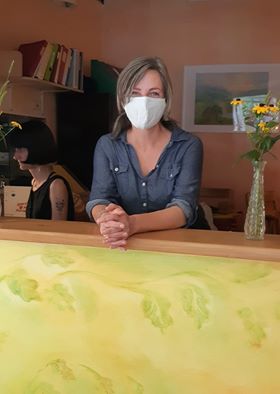Superbowl champion and medical doctor Laurent Duvernay-Tardif is often seen knitting during interviews. It’s a skill he picked up at his alternative primary school.
“I did sculpture, pottery, watercolours and knitting,” said the Kansas City Chiefs linebacker in an interview with La Presse, “I can knit socks and make heels using four needles.”
The Waldorf school Duvernay-Tardif attended is now closed. However many of his specially trained educators went on to teach at NDG’s Waldorf school, École Rudolf Steiner de Montréal. The school follows a philosophy that eschews traditional teaching methods in favour of developing the whole child through play and art-based learning.

The Kindergarten to grade 8 school, located in the old Frazer Hickson library building on Kensington Avenue, is set to reopen August 27 for the first time since the pandemic forced it to shift learning online. And while the Quebec Education Ministry’s back-to-school plans have a lot of parents and teachers anxious and worried, the atmosphere surrounding the re-opening of the alternative school is a bit different.
“Most of our parents are pretty cool, in general,” says Nathalie Senécal, the school’s development officer, explaining that she hasn’t felt much pandemic related anxiety from parents she’s spoken with.
On a mid-August afternoon, there are freshly picked black-eyed Susans sitting in vases near the school’s entranceway. The bright, airy hallway is lined with well-watered, happy-looking plants. The staff who wander down the corridors seem relaxed and content.
Senécal says the subsidized private school, whose motto is “building a better world together,” has a pedagogy that adapts easily to a society in transition. “It’s about doing,” says Senécal, smiling, “We’re looking forward to making face masks with the kids.”
Waldorf schools are based on a philosophy developed by the Austrian scientist and philosopher Rudolf Steiner at the end of the First World War. Steiner thought creating a better world started with keeping children in their imaginative, dreamy states as long as possible. He saw art and free, uninhibited play as the key to generating new visions for a society on the brink of collapse.
Steiner also believed teaching shouldn’t be centered on grades or ages, but on developmental stages. He divided these stages into 7-year periods he called early childhood, middle childhood and adolescence. Waldorf teachers use practical, creative work to hone academic skills. Making blueberry jam, for example, could be part of a math lesson.
When Waldorf schools celebrated their one hundredth anniversary last September, the NDG school received postcards from affiliated schools all over the world. They still decorate the wall of the school’s large, central room. But the classroom’s warmly coloured lazure painted walls remain empty, waiting to be brightened up by children’s art that will hang from the clothespin lines that stretch across them.
Senécal says the school, home to about 150 students, is still working out some of the details of their COVID-19 plans. But along with a curriculum which can be easily modified, class sizes are already small, averaging 17-19 students in a cohort. Students sit on cushions at moveable desks. And there is already a lot of outdoor play included in the school day. All Waldorf classrooms have sinks in them, which will make hand washing and cleaning easier.
The building’s physical structure also makes it easier to apply the new government regulations, says Senécal. Its numerous entrances facilitate the staggering of arrival times for different age groups and the large, high-ceilinged multi-purpose room, which used to be the old library’s reading room, may even make singing—an integral part of the Waldorf curriculum– possible.
“We have to clear this with the minister, whether it’s possible if we create enough distance,” says Senécal.
One thing that won’t happen this year is handshakes, says Senécal. A normal Waldorf school day begins with each child shaking a teacher’s hand while they look each other directly in the eye. However, says Senécal, “A lot of things we would do typically will help heal the distance that was created (during the break).”
For students who’ve been living their lives online, coming back to school will mean the return of specially designed Waldorf toys. The toys are made of soft, smooth, natural materials and encourage a connection with the earth and the physical world.
Senécal says her son, who is in grade 7, has spent a lot of time on zoom with his friends recently, an experience she describes as “alienating.” Reopening she says, “will be about bringing kids back into their bodies, their hands, coming back to their heart, to their friendships and their relationships with teachers.”
Correction: * An earlier version of this story stated Duvernay-Tardif attended Waldorf school in NDG. The NDG Echo regrets the error.